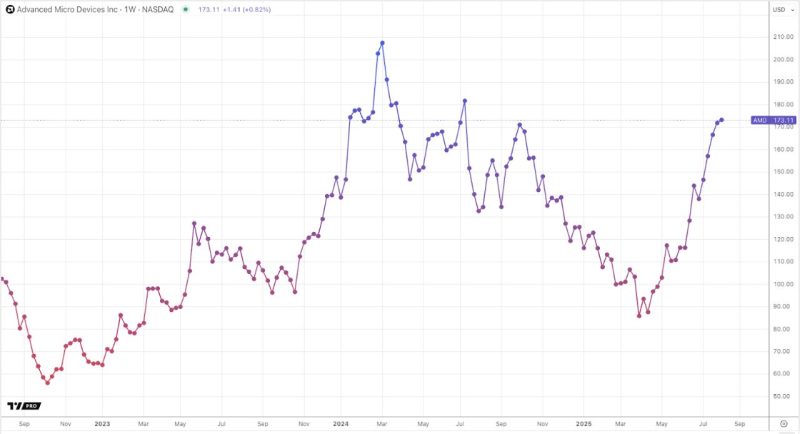
AMD has always stood out from the general list of technology companies, especially when it has established its position in the market, and this is confirmed by the non-standard schedule for publishing quarterly reports.
Unfortunately, such a unique phenomenon periodically works against the company, as this time, when analysts formed inflated expectations that even record revenue figures could not fully meet. Because of this, investors were disappointed, and stocks reacted with a decline, which, fortunately, did not impact the Dow Jones index or Dow Jones futures.
Formally, the largest chip manufacturer showed strong results because revenue increased by 32% to a record $7.69 billion for the second quarter, exceeding analysts’ forecasts. However, the key non-GAAP EPS indicator turned out to be slightly below expectations — 48 cents compared to the projected 49 cents.

The profit trends have become complex due to differing calculation methods:
- GAAP net income increased more than 3 times to $872 million.
- Non-GAAP profit decreased by 31% to $781 million.
The export ban of Instinct MI308 accelerators to China has become a key hindrance to the upward momentum. As a result, the warehouse stock of unsold products surpassed $800 million. In addition, the US administration’s sanctions policy puts a lot of pressure on the entire sector. AMD’s non-GAAP profit margin was 43%, whereas it could have reached 54% without this factor. GAAP operating losses reached $134 million.
The Data Center segment’s revenue increased by +14% to $3.2 billion, provided exclusively by EPYC series processors. The accelerator division, traditionally key to AI, saw revenue decline by 12% in the quarter, with operating losses of $155 million. The reason remains the same: restrictions on the MI308 and the transition to the new generation MI350.
Client and Gaming solutions, on the other hand, demonstrate explosive growth. Total revenue increased +69% per annum to $3.6 billion. Separately, Gaming showed +73% to $1.1 billion. This includes discrete graphics and console chips. Customer solutions increased by 57% to $2.5 billion. This is due to the strong demand for Ryzen chips based on Zen 5. Total operating profit increased more than fourfold to $767 million, and margins increased from 8% to 21%.
Embedded and Xilinx solutions decreased revenue to $824 million (-4%), operating profit of $275 million (-20%), and the margin decreased from 40% to 33%.
AMD management associates the future growth of AI with new accelerators. Deliveries of the Instinct MI350 began in June, earlier than planned. According to Lisa Su (CEO), demand significantly exceeds expectations, which was the reason for this decision. The average order completion time for the MI350 and future MI400 is 8–9 months. The company positions the MI350 as a competitor to the Nvidia B200 in training and inference tasks. Notably, 7 out of 10 leading LLM developers already use Instinct solutions.
The warming of relations with China may lead to long-term implications. The ban on some accelerators was lifted in June, and Lisa Su expressed hope for obtaining licenses to resume deliveries of the MI308. However, the forecast for the current quarter ($8.7 billion, above the market $8.3 billion) does not include revenue from resumed operations in the Chinese market.
AMD has fairly high expectations for Q3 — $8.7 billion in revenue (+13%) and growth in all segments. The company considers the launch of MI350 shipments and steady demand for EPYC/Ryzen to be the main growth drivers. The CEO predicts stability in the gaming segment in the coming quarter, but expects a decline in Q4. In the long term, Lisa Su estimates the potential of AMD’s AI business at tens of billions of dollars, emphasizing the demand not only for GPUs, but also for CPUs, where AMD’s position is traditionally strong.
